In sweltering concrete jungles like Taipei, rooftop gardens are often touted as an effective means of bringing nature back into the city and addressing ecological issues.
The consensus among architects, academics and government officials in Taiwan is that a properly designed, constructed and maintained rooftop garden is entirely beneficial for a building, its residents and the environment in general.
A green roof costs more to build and maintain than other roofs, but the potential energy savings may be able to offset those costs.
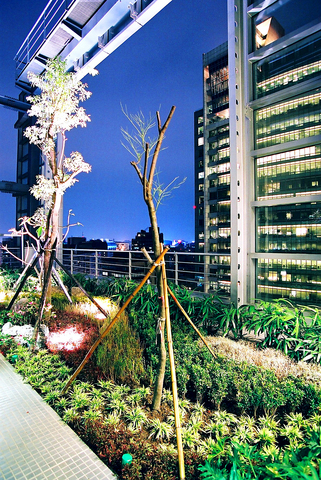
PHOTO COURTESY OF HOY ARCHITECTS AND ASSOCIATES
HISTORY
From 1974 to 1990, the Taipei City Government provided free soil, fertilizer, plant material and reference books to residents who applied to construct rooftop gardens.
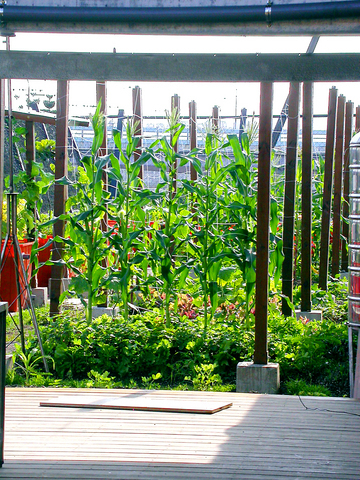
PHOTOS COURTESY OF ANNIE LIU
In 1990 the grant policy was put under the administration of district offices, allowing each district to decide how best to distribute the money. Then in 1996 the Public Space Improving, Greening and Beautifying Project (
Although there was considerable interest in the project, which would receive 70 to 100 applicants a year, it was axed in 2000 due to budget cutbacks, according to Wu Shu-Jun (
The Taipei City Government no longer enacts programs to encourage rooftop gardens, but Wu said the department of urban development and the department of civil affairs are working on a new environment-improvement project that will provide advice but no funding to district communities interested in establishing garden areas.
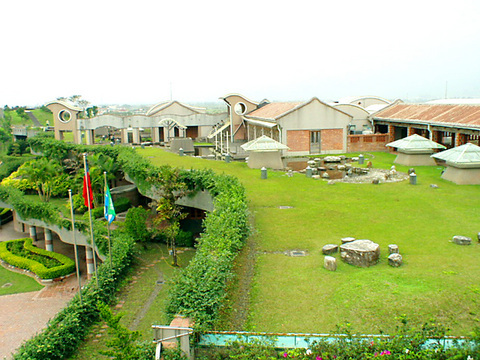
PHOTO COURTESY OF KEVIN WU
The only national government incentive currently in place is the Green Building Evaluation and Labeling System launched in 1999 by the Architecture and Building Research Institute (ABRI), under the Ministry of the Interior.
A building's environmental credentials are measured using nine indicators: biodiversity, greenery, soil water content, energy saving, indoor environment, water resource, sewage improvement, carbon dioxide emission and waste reduction.
At present only government buildings are required to pass the green building evaluation. Mostly, the credentials are to assist the public and professionals in understanding sustainable building concepts. Although rooftop gardens are not explicitly included in the evaluation, they can be used to earn points in several of the nine categories, explained ABRI research associate Chiu Chiung-yu (
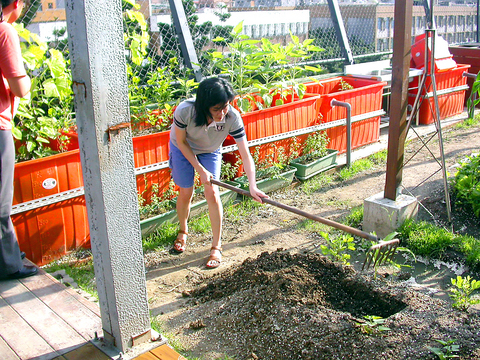
GREEN ROOF CASE STUDY
"Rooftop gardens are the first step in sustainable development for buildings," said TC Chang (
The graduate department began a rooftop project less than a year ago and the barren concrete rooftop of a 30-year-old building has been transformed into a thriving garden and recreational area.
On one side of the roof is a fully developed garden growing corn, watermelon, eggplant, green beans, lettuce, squash and cucumber, while the other side is covered with an assortment of plants, grass and flowers. A wooden deck, small washroom facility and open kitchen area are being constructed in the center.
All the rooftop facilities will ultimately run on alternative energy sources supplied by a solar panel and two small windmills. Circulating the outer rim of the roof are plastic containers collecting rainwater that is siphoned into a storage area under the wooden deck and then drained into water containers and used for irrigation.
Later a system may be implemented to use the rainwater for "gray water" purposes such as washing, showering and eventually it will be filtered for drinking. A compost system that utilizes food waste from the university is also being developed to replace the store-purchased fertilizer.
"In the beginning, we had no idea of the multiple benefits this project would have -- management of rainwater, composting and now harvesting food," said Chang, pointing to the 1m-tall corn plants.
The most practical ecological discovery derived from the experiment thus far is the management of rainwater. According to research studies in environmental journals cited by Chang, between 15 to 90 percent of rainwater runoff can be absorbed, depending on soil depth and rain intensity.
A similar percentage of water can also be absorbed by vegetation, instead of being discharged into groundwater, streams or rivers. An adequate water retention and runoff channel on the surface area of a building, he said, will drastically reduce the volume of rainwater flowing into Taipei's over-stressed sewer systems.
For Chang his active classroom experiment confirms what he had always hypothesized. "Existing buildings were not constructed with ecology in mind, but with the techno-logy and knowledge we have now there is no reason why at least one quarter of the roof cannot be green," Chang said.
GOING GREEN
There is no evidence to show how much impact the interior ministry's green-building certification has had on Taiwan's building industry and to what extent it can be used to market properties. More architects, however, are finding sustainable development and design difficult to avoid.
"The government is concerned about how green [environmentally sound] a building is, but they don't care about what a building looks like. We need to apply ecological factors with artistic design so we get sustainable buildings that people can enjoy living in," said Mark Ongg (
The economics of land development often dictate that facilities require minimum investment and low maintenance, because they are easier to sell and reap more profit, Ongg said.
"Sustainable development is becoming a serious issue in Taiwan, and while architects are starting to go that way, land developers and owners are more concerned with making money. We should reverse this philosophy and invest in the future of our environment," he said.
MONETARY REWARDS
According to Ongg, a well-designed rooftop garden can increase the cost of construction by five to 10 percent, and depending on the garden, it can take three to 50 years to recover those costs in energy savings -- a wide time frame for developers looking to turn a quick profits.
The biggest savings incurred from garden rooftops are measured in cooling and heating costs.
Solid, infertile surfaces like concrete absorb small amounts of energy but redirect most of it to other hard surfaces, resulting in rising temperatures. An impervious green area acts as a natural insulator making it cooler in summer and warmer in winter, helping to alleviate the urban-heatsink issue.
In an effort to reduce urban heat in Tokyo, the Green Tokyo Plan was implemented in 2001, requiring rooftops on all new buildings to include at least 20 percent greenery.
The HOY Architecture firm has conducted research that found rooftop gardens provided an average 6o decrease in temperature in the summer time.
This translates into a 10-percent reduction in air conditioning requirements for the top-floor apartment, Ongg said. At present there is little economic incentive for integrating a roof with rainwater collection and gray water filtration, given that water is comparatively inexpensive in Taiwan. Water shortages in recent years, however, might provide a future argument for government incentives to develop such systems.
RECREATIONAL ADVANTAGES
Other benefits to rooftop gardens rest in their recreational advantages.
"The most important thing is how it relates to the building structure and how it can provide residents with a better lifestyle at home or at work," Ongg said.
Private and public corporations have shown increased interest in developing greenery areas in the last five years, he said, citing two Fubon buildings his firm has constructed. Yilan City Government also scored high on the green-building evaluation, with its rooftop area that includes walkways and seating areas for employees to eat lunch and relax on their breaks.
While residential gardens provide urban dwellers with a communal gardening space, the rooftop is a public space so that all tenants must agree beforehand on who will incur the construction and maintenance costs.
If initial agreement is made, there is also the issue of space.
Most rooftops are already crowded with unused equipment, water coolers and makeshift homes or sheds.
"Taiwan rooftops are not pretty and architects have realized this and taken the space into consideration when designing new buildings. Old buildings are a problem, because how can you have a garden with all that stuff up there?" Ongg said.
Increased structural loads are almost a non-issue for Taiwan's concrete buildings due to their comparatively heavy roofs, which play a role in bracing the buildings against seismic forces and the wind.
Prolonged exposure to the sun and wind, however, means that gardens require daily watering or a timed irrigation system to be installed. Likewise a durable waterproofing system needs to be implanted to stop water leakage from drainage backups or root puncture that could damage apartments below.
New buildings are able to take the desired function of the roof space into account, allowing for bracing, waterproofing and accommodation for the extra structural load to be included in early stages of design.
For older buildings, a thorough test would need to be conducted to determine the load-bearing capacity, drainage management, moisture and root penetration resistance on the waterproofing agent before construction, said Kevin Wu (
"Rooftop gardens require a detailed knowledge of plant biology, hydraulic engineering and architecture. It's not only about what looks good."
This is why Wu said it is best for landscapers or architects to be involved in the design and construction of rooftop gardens. At present interior designers design most gardens on old buildings in Taipei because landscapers and architects tend to focus on large projects, such as new buildings or park designs.
DO-IT-YOURSELF
Properly installed rooftop gardens require waterproofing, insulation, drainage, filter fabric, growth media, plant material, water storage and irrigation. Neither Wu nor Ongg were against DIY gardens but both recommended, "keeping it simple."
Instead of building a stationary garden, pots or containers that guard against leakage can be used, enabling gardeners to play with different designs, Wu said.
Other possibilities include creating a trellis system with one plant (such as grape vine) and bracing it with bamboo or steel. Those determined to use soil and plant vegetation need to first determine if the building's existing waterproofing is still intact and able to withstand large quantities of water.
Advice on waterproofing agents and root deterrent products is available from B&Q or the many flower markets in Taiwan.
Both Wu and Ongg recommend consulting a structural engineer or architecture association before undertaking any extensive roof garden projects that involve additional structural supports or complex waterproofing.
Similarly, major construction might require a permit form the city building administration.

A vaccine to fight dementia? It turns out there may already be one — shots that prevent painful shingles also appear to protect aging brains. A new study found shingles vaccination cut older adults’ risk of developing dementia over the next seven years by 20 percent. The research, published Wednesday in the journal Nature, is part of growing understanding about how many factors influence brain health as we age — and what we can do about it. “It’s a very robust finding,” said lead researcher Pascal Geldsetzer of Stanford University. And “women seem to benefit more,” important as they’re at higher risk of

March 31 to April 6 On May 13, 1950, National Taiwan University Hospital otolaryngologist Su You-peng (蘇友鵬) was summoned to the director’s office. He thought someone had complained about him practicing the violin at night, but when he entered the room, he knew something was terribly wrong. He saw several burly men who appeared to be government secret agents, and three other resident doctors: internist Hsu Chiang (許強), dermatologist Hu Pao-chen (胡寶珍) and ophthalmologist Hu Hsin-lin (胡鑫麟). They were handcuffed, herded onto two jeeps and taken to the Secrecy Bureau (保密局) for questioning. Su was still in his doctor’s robes at

Last week the Democratic Progressive Party (DPP) said that the budget cuts voted for by the China-aligned parties in the legislature, are intended to force the DPP to hike electricity rates. The public would then blame it for the rate hike. It’s fairly clear that the first part of that is correct. Slashing the budget of state-run Taiwan Power Co (Taipower, 台電) is a move intended to cause discontent with the DPP when electricity rates go up. Taipower’s debt, NT$422.9 billion (US$12.78 billion), is one of the numerous permanent crises created by the nation’s construction-industrial state and the developmentalist mentality it
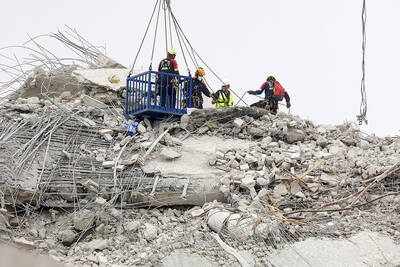
Experts say that the devastating earthquake in Myanmar on Friday was likely the strongest to hit the country in decades, with disaster modeling suggesting thousands could be dead. Automatic assessments from the US Geological Survey (USGS) said the shallow 7.7-magnitude quake northwest of the central Myanmar city of Sagaing triggered a red alert for shaking-related fatalities and economic losses. “High casualties and extensive damage are probable and the disaster is likely widespread,” it said, locating the epicentre near the central Myanmar city of Mandalay, home to more than a million people. Myanmar’s ruling junta said on Saturday morning that the number killed had